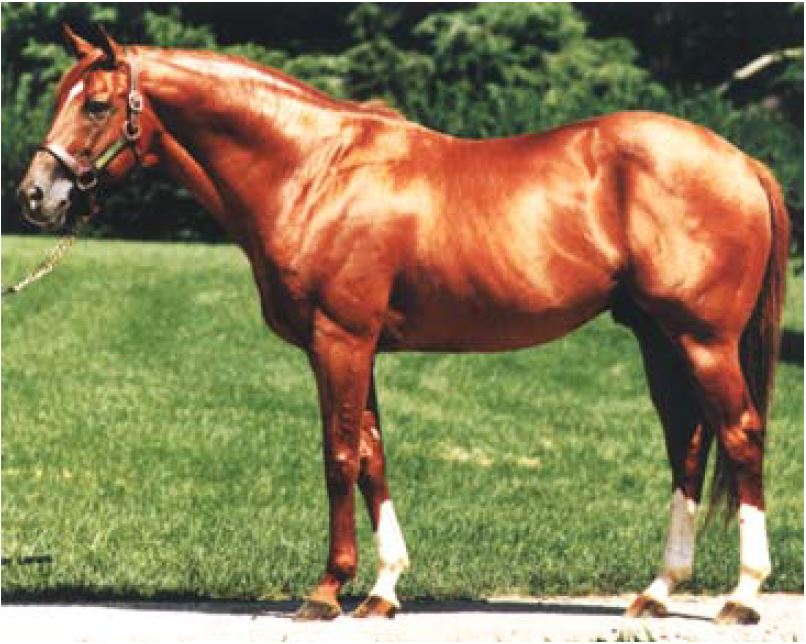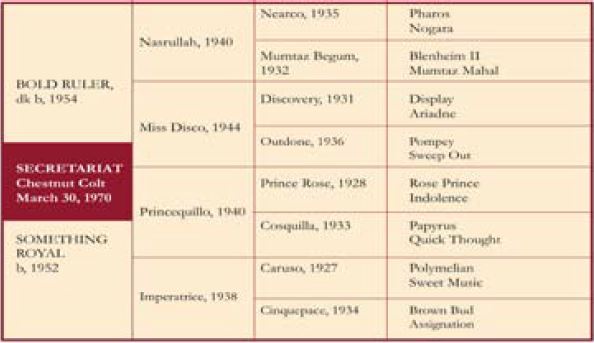SECRETARIAT
 Jockey Ron Turcotte was in for the ride of his life the afternoon of June 9, 1973, at Belmont Park aboard Meadow Stable’s Secretariat, and the world of racing would be blessed with an historic moment that would match the magnificence of Don Larson’s perfect World Series game, Roger Bannister’s sub-four-minute mile, Gene Sarazen’s double eagle in the Masters, and Wilt Chamberlain’s 100-point game. Coming as it did shortly after Secretariat was featured on the covers of Time, Newsweek and Sports Illustrated helped stamp it into the nation’s consciousness.
Jockey Ron Turcotte was in for the ride of his life the afternoon of June 9, 1973, at Belmont Park aboard Meadow Stable’s Secretariat, and the world of racing would be blessed with an historic moment that would match the magnificence of Don Larson’s perfect World Series game, Roger Bannister’s sub-four-minute mile, Gene Sarazen’s double eagle in the Masters, and Wilt Chamberlain’s 100-point game. Coming as it did shortly after Secretariat was featured on the covers of Time, Newsweek and Sports Illustrated helped stamp it into the nation’s consciousness.
[twocol_one][dropcap]T[/dropcap]he morning before the Belmont, retired Hall Of Fame trainer Hollie Hughes was at the track, as he motioned Turcotte over so he could say a few words to him. As a young man, Hughes had sent out George Smith to win the 1916 Kentucky Derby and the list of horses he had seen around that time included the big three from the first part of the century: Sysonby, Colin and Man o’ War.
“He was a man of few words, but he had something to say to me that morning,” Turcotte recalled. “He said, ‘Son, there is no way you can get this horse beat today – just don’t fall off. Believe me boy, you are riding the greatest horse of all time and I have seen them all.’
” Race day came and the 67,605 fans in attendance and the millions more watching on television witnessed the greatest exhibition of speed and stamina ever seen on the American Turf. Announcer Chic Anderson provided millions of listeners a lasting impression of Secretariat’s record performance midway through the one and a half-mile race. “Secretariat is blazing along! The first three-quarters of a mile in 1:09 4/5. Secretariat is widening now. He is moving like a tremendous machine!”
Secretariat, and Anderson, didn’t let up over the next threequarters of a mile after disposing of rival Sham. The homebred son of Bold Ruler was in front by seven lengths after a mile in 1:34 1/5, by twenty at the quarter pole in the time of 1:59, by twenty-eight with a furlong to go, and finally by thirty-one under the wire in a world-record time of 2:24. The time shattered both the time and stakes record of 2:26 3/5 set by Gallant Man in 1957 and the American dirt record 2:26 1/5 set by Going Abroad at Aqueduct in 1964.
Few had doubted Secretariat’s greatness before the Belmont, and the universal praise after the performance was best expressed by veteran Turf coloumnist Charles Hatton. “His only point of reference is himself,” said Hatton, who also had seen Man o’ War run. Kent Hollingsworth of The Blood-Horse wrote, “Two twenty-four flat. I don’t believe it. But I saw it. I can’t breathe. He won by sixteenth of a mile. I saw it. I have to believe it.”
The victory eclipsed to some extent the appreciation of Secretariat’s track-record time of 1:59 2/5 in the one and a quartermile Kentucky Derby
[/twocol_one] [twocol_one_last]and the colt’s unofficial record-time of 1:53 2/5 registered by veteran Daily Racing Form clockers in the one and three-sixteenths-mile Preakness Stakes. The Derby time bettered Northern Dancer’s record time by three-fifths of a second if only it had counted. The 1:54 2/5 recorded by Pimlico’s official timer is listed as the official time.
The Triple Crown pursuit and triumph took a hold on the nation to such an extent that it bestowed a certain amount of stardom on Meadow Stable’s Helen (Penny) Chenery. Chenery, who was married at the time to John Tweedy, wore that stardom like a champ. On behalf of family members, Chenery had taken over the management of the Meadow Stable operation after her father, farm patriarch Christopher T. Chenery, became ill. She retained the role as manager following her father’s death in January of 1973 and spearheaded the deal in which Secretariat was syndicated for breeding purposes for a record $190,000 per share in the first part of his three-year-old season. Secretariat’s total value was placed at $6.08 million and the colt was billed as being worth his weight in gold.
Secretariat was a product of a foal-sharing arrangement between Meadow Stud and breeder-owner Ogden Phipps, whose mother, Mrs. Henry Carnegie Phipps, bred and raced the great Bold Ruler. Meadow stud and Phipps would toss a coin to determine which party got which foal from the mating of Meadow Stud mares to Bold Ruler. Secretariat’s fate was decided at the Saratoga meeting in 1969 when Meadow Stud won the coin toss for yet another unborn foal of Somethingroyal, whose earlier offspring included champion Sir Gaylord. Secretariat, who was foaled at the Meadow near Doswell, Virginia, on March 30, 1970, was bred in the name of Meadow Stud.
The Belmont Stakes might have been Secretariat’s defining moment, but it wasn’t the last of his great races. After the Belmont, Secretariat was taken to Chicago, where Mayor Richard Daley honoured him by declaring June 30 “Secretariat Day.” Secretariat easily won the Arlington Invitational at one and one-eighth miles, just missing Damascus’ track-mark of 1:46 4/5 by a fifth of a second. Turcotte later said, “If only I had let him run for two jumps, that would have been another record.” The following year, Arlington[/twocol_one_last]
Page 1
[twocol_one]honoured Secretariat by running the Secretariat Handicap, which later gained grade I status. For comparison, it wasn’t until 1959 (in New York) when Man o’ War was honoured with a race.
Secretariat then shocked the racing world by losing the Whitney Stakes at Saratoga. Many blamed Turcotte for keeping Secretariat nearest to the rail for much of the trip, but it later was learned that the colt suffered from a fever.
Secretariat redeemed himself in the inaugural Marlboro Cup Invitational Handicap in September, setting a world-record mark of 1:45 2/5 for the one and one-eighth miles and winning over older stable-mate Riva Ridge, Cougar II, Onion, Annihilate ’em, Kennedy Road and Key to the Mint. After that, Secretariat lost the Woodward Stakes over a sloppy track while deputising for Riva Ridge. The loss marked his third defeat in a stakes beginning with the letter W. (The other two were Whitney and Wood Memorial in the spring.) About a week later in his turf debut, Secretariat captured the one and a half-mile Man o’ War Stakes at Belmont in course-record time of 2:24 4/5.
Secretariat ran his final race in the Canadian International Stakes at Woodbine in late October. More than a half-century later, Man o’ War had bidden farewell to racing in Canada, going out a winner over Triple Crown winner Sir Barton. Secretariat captured the one and five-eighths mile Canadian International by six and a half lengths for his sixteenth career win in twenty-one starts. He had been trained throughout his career by Lucien Laurin and was ridden by Turcotte in all but his first two starts and his finale. Secretariat was named champion three-year-old male, and picked up his second Horse of the Year title. As a two-yearold in 1972, he had won theFuturity, Hopeful, Garden Gate [/twocol_one] [twocol_one_last] Stakes, and Sanford Stakes as well as the Laurel Futurity. He had finished first in the Champagne Stakes, but was disqualified and placed second.
 [dropcap]S[/dropcap]ecretariat arrived for stallion duty at the Hancock family’s Claiborne Farm near Paris, Kentucky, in November of 1973, and was placed in the stall once occupied by Bold Ruler. Doubts about his fertility were raised following tests, but nothing ever came of that, and he ended up siring 653 foals, fifty-seven of which became stakes winners. A colt from his first crop of foals was sold for a then-record $1.5 million at the 1976 Keeneland July yearling sale.
[dropcap]S[/dropcap]ecretariat arrived for stallion duty at the Hancock family’s Claiborne Farm near Paris, Kentucky, in November of 1973, and was placed in the stall once occupied by Bold Ruler. Doubts about his fertility were raised following tests, but nothing ever came of that, and he ended up siring 653 foals, fifty-seven of which became stakes winners. A colt from his first crop of foals was sold for a then-record $1.5 million at the 1976 Keeneland July yearling sale.
Secretariat’s stallion career was plagued by the perception that he was a modest stallion because he never sired a runner whose ability matched his, but a list of his added-money winners reveals the names of Horse of the Year Lady’s Secret, champion and Preakness/Belmont winner Risen Star, and other good ones. Secretariat’s biggest mark came as a broodmare sire, his material grandsons including Storm Cat, A. P. Indy, Summer Squall, Gone West, Secreto, Chief’s Crown, and Dehere. Secretariat, whose likeness is portrayed in a bronze sculpture at both Belmont Park and the Racing Hall of Fame, was elected to the Hall in 1974. He was euthanised at age nineteen on October 4, 1989, because of complications from laminitis and buried at Claiborne. Time magazine ranked Secretariat among the century’s ten most influential athletes.[/twocol_one_last]
Extract from “Thoroughbred Champions: Top 100 Racehorses of the 20th Century” Published by Eclipse Press A Division of Blood-Horse Publications To order, go online: www.ExclusivelyEquine.com
Publishing Date: June – July 2008.
Page 2












